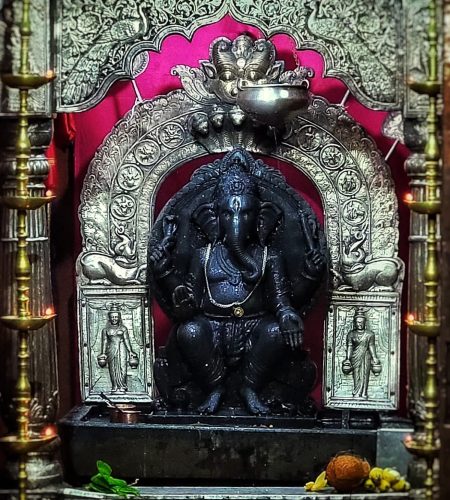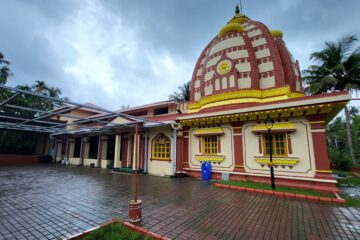Since childhood, Ganapati has been a beloved deity for people of all ages! While there are numerous temples dedicated to Ganapati in Goa, the most famous among them is the Mahaganapati Temple in Khandola. Located on the road from Marcel to Savoi-Verem in Ponda Taluka. The path leading to the temple is slightly sloping, on the left-hand side. As we descend this slope, the shaded courtyard surrounded by trees instantly brings a sense of calm.
The Assembly Hall


Typically, other temples have a rectangular assembly hall with a Antaral (Anteroom) in front, followed by a central hall (chowk). However, here, the assembly hall is wide, and instead of the main temple directly ahead, we can see stairs leading to the temple in the far-left corner of the hall.
The beautiful Temple and the Four-Armed Idol
This beautiful temple faces east. Instead of a dome, we see the temple’s spire on a pyramid shaped beautifully tiled roof. The temple’s design is similar to other Goan temples.
The main idol in the sanctum is a four-armed seated figure made of black stone, so captivating that one could gaze at it for hours. Above the sanctum’s main entrance are carvings of Ganpati, Riddhi-Siddhi, Saraswati, and Kartikeya. Outside the sanctum, above the entrance, hangs a canopy made of artificial fruits, known as “Matoli.” Matoli is an integral part of Ganesh Chaturthi celebrations in Goa.

Laxmi Narayan, Ravalnath, and Shantadurga
The Temple Premises


The History of the Temple
The Story of Kalbhairav and Nirankal Temples
A small temple of Kalbhairav located outside the temple has an interesting backstory. Historian Mr. Pereira gifted the temple the original Kalbhairav stone idol, which was found in his ancestral home in Divar. Not realizing its significance, the family used it to weigh rice. However, they noticed that the stone started weighing slightly more than expected. Curious, they chipped off a corner of the stone, but its weight continued to increase. After more attempts, they decided to donate the stone to the Mahaganapati temple. When a divine message was sought, it was revealed that the stone should be installed outside the temple as Kalbhairav. Today, both the Kalbhairav and Nirankal temples can be seen next to the assembly hall.
Distance from Panaji to Khandola
.


